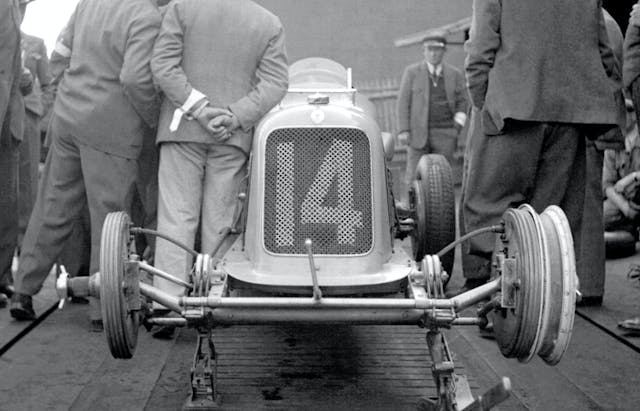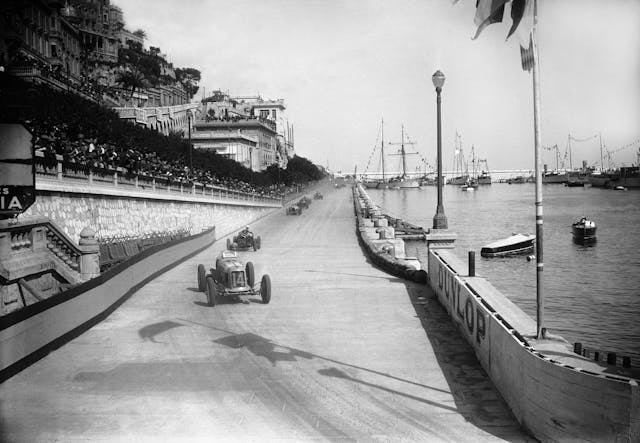In the Moment: Maserati and the line between
Welcome to a new weekly feature we’re calling In the Moment!
This all started in Slack, the messaging software we use for staff communication. Several weeks ago, Hagerty’s editor-at-large, Sam Smith, began kicking off our mornings by plopping a random archive photo into our chat room.
In addition to being a lifelong student of automotive history, Smith drinks a lot of coffee. Each photo he dropped into the conversation was accompanied by a few paragraphs of caffeine-fueled explanation.
We liked these drops a lot, so we’re sharing one here each Thursday. Enjoy, and let us know what you think in the comments! —Ed.
**
This is a Maserati. One of the greatest.
Look at that front axle. It is gorgeous and slim and we are going to talk about it.
But first, we must discuss the brothers.
Maserati was—is—a last name. Alfieri, Alfieri II, Carlo, Bindo, Ernesto, Ettore, Mario. The oldest of those siblings was born in 1881, the youngest in 1894. Their parents, Rodolfo and Carolina Maserati, lived in the town of Voghera, in the province of Pavia. Up near the Milan-Turin-Genoa triangle, at the top left of Italy’s boot, about 50 miles from the sea.

Voghera currently holds around 40,000 people. The city’s wiki mentions the Italian colloquialism “Voghera housewife.” These words, the site says, are used by the media to represent “an average person who … with hard work and self-sacrifice, [tries] to raise a family as best as possible.”
Rodolfo Maserati was a railway worker. Only six of his seven sons survived childhood; his third, Alfieri, was born in 1885 and died a year later. The next son to come along was also named Alfieri, or Alfieri II. (This strikes your author as very Italian, but then, so does The State’s “Da Pope-A” sketch. Italian culture is an incredible pile of figurative sauce and hand gestures.)
The firm that became the car company was born in 1914. It was incorporated by Alfieri II and grown with the help of Ernesto and Ettore. Carlo was gone by then; he died in 1910, of tuberculosis. Mario designed the company logo but had no real interest in cars. Bindo didn’t really get involved until the early 1930s, after Alfieri had died of complications from a racing accident.

All you really need to know is that four of Rodolfo’s sons were nutty for speed and engineering. These were creative and industrious men, and they did creative and industrious things.
Click on these words. Look at the man! Tell me you cannot imagine him making scowly faces about stuff in which he strongly believes! That photo is beyond glorious; more to the point, it is Italian as hell.
So, as it happened, were early Maseratis. The marque’s first purpose-built vehicle, a racing car, did not appear until 1926. It was called the Tipo 26, or Type 26. The ten years that followed were a golden era—the firm’s engineering was among the best in the world. Those brothers went grand-prix racing. Their cars were small and delicate where possible but strong enough where required. Years before Enzo Ferrari owned a factory, before that mercurial man was a household name, the pyramid of Italian speed art was capped by Maserati and Alfa Romeo and everyone else sat below.
Starbucks will now sell you coffee that the company calls “artisan.” How we have ruined that word. Look at the timing gears of an 8CM, good for nearly 6000 crankshaft rpm at a time when most road cars worked like a Ford Model A.
In the modern world, of course, Maseratis are also different. The badge has not been a bright light since the 1960s. The marque is now owned by Stellantis, so new Masers whiff of Mopar and Ferrari and depressing resale. The Maserati brothers, for their part, sold the company in 1937. They stayed on for a bit, legally obligated, then founded another firm, OSCA. Which is also no more.
If running an Italian car company were a game of Bingo, half the squares would read BUILD HEARTBREAKING POEM ON WHEELS. The other half would read AY! WHERE WENT ALL-A THE LIRE!?!

Back to that picture. The image at the top of this page shows a Maserati 8CM grand-prix car. It is sitting on a weighbridge, on screw jacks, likely before a race.
The image is from the Getty Images archive; the caption does not give year or location. 8CMs were built from 1933 to 1935. They were Maserati’s first true grand prix car, a swing-for-the-fences effort that made large dent in the sport. It may be coincidence, but an 8CM wearing number 14 also lives in Getty, in a 1934 shot of the Monaco Grand Prix. The driver, the caption says, is a Le Mans-winning Frenchman named Philippe Étancelin.

So much to see in that shot! The tall ships and bunting in the harbor; the crowds up the hill; the wooden barrier at the apex, in front of a stone wall. Imagine a world where a few planks and some air are seen as safety. What it would feel like to hit them.
Our man Philippe is in front. In that 140-mph, 1700-pound 8CM, with its solid axles and drum brakes and its 3.0-liter, 260-horse straight-eight. Monaco has been an F1 track since the sport’s beginnings. A claustrophobic and narrow place that has narrowed through the years, the cars growing wider and faster.
Back to the weighbridge shot. So much seems foreign to modern eyes. That gorgeous front axle was a single forged piece, hung on quarter-elliptic leaf spring. The slender finned housings at each end are brake drums; the little mesh-covered rectangles on the backing plates are cooling scoops. It is hard to imagine those scoops ever being able to flow enough air. The lines running to the plates, above and behind, are hydraulic, carrying brake fluid.

In 1934, hydraulic brakes were neither old hat nor free from debate. Ettore Bugatti hated them, for example. For him, traditional mechanical brakes—rods and linkages connecting foot to axle—were smarter. Less prone to failure.
Ettore was wrong about that. We’ll forgive him.
The chassis here is colloquially known as a “ladder” frame. The idea stretches back to the horse-drawn carriage. Some ladder frames actually look like a ladder, while others just sort of echo the concept. On a car like this, chassis flex is designed in, part of suspension travel and spring rate. I have driven—track-tested—just one pre-war Grand Prix car, an Alfa Romeo P3. That very car was famously raced at the Nürburgring, in 1935, by a man named Tazio Nuvolari. In 1933, Nuvolari drove for Maserati. In early testing of the 8CM, he asked for more stiffness in the chassis. Maserati added bracing to the front of the ladder. The car gained grip, went quicker, began winning.
Make a ladder frame too stiff, the suspension will work less effectively. The line between is … thin.
Racing in this era was mostly on public roads. Pavement occasionally, but also cobblestone or dirt. Drivers in shirtsleeves.

Now look, once more, at that front axle. Outside each frame rail, tucked to the inside, is a single friction damper. A shock absorber. It looks like two small frisbees stacked together. Each assembly holds a stack of clutch plates arranged around a central threaded shaft and capped on the end by a metal plate. Steel arms connected to the axle run between the clutches. The plate is held on by a nut. Tighten the nut, you clamp the clutches tighter, adding preload, effectively stiffening the damper.
Friction dampers work alright. Not great. Compared to a modern shock, they mostly exist so a given spring does not endlessly hump about.
Now put the whole picture together. Imagine making one of these cars go as fast as it can. While also knowing you are, the whole time, extremely close to death. Or at least light dismemberment, a plank to the face.

We’re all on an arc, right? A curve to somewhere, but we don’t know the end? Yesterday is not today and tomorrow isn’t here yet, but they’re all on the path. Being even half alive means keeping stock in all three. The balance is different for everybody.
“Nostalgia” is rooted in ancient Greek—nostos algos. The pain of being unable to go home. Some cultures view the concept as poison, and it may be. I know more than a few people who seem determined to live in the past—theirs or someone else’s, real or imagined. We are so often blind to what we can accomplish, too focused on what we’ve already done. Worse, we often judge others through similar lens.
The Maserati brothers spent maybe a decade at the top of their game. By the late 1930s, when they sold, the marque was less than it had been. This did not stop the new owners from doing great things with it.
I love history. It always makes me wonder what will happen tomorrow.
Have a good day, guys!
—Sam



Incredible. Smith’s words bring the history into 3-D clarity. I can smell the unburned hydrocarbons.
What is sad is how this legacy has been squandered. Today Maserati has gone from an Iconic name to a much more mass production car.
Yes they have a rebodied Ferrari but their cars used to be a rare and exotic sight but today it is just another car in the Barnes And Nobles parking lot in the snow.
It is sad how cars that once were built with artistic craftsmanship have become just another car.
I get it times change and economics change. Yes Maserati went through some very tough biturbo years but I often think they like James Dean may have done better by going before their time.
Great look into the past. Really puts those drivers into perspective. Thanks Sam!
Maserati had some amazing cars for it’s day. Today, nothing too spectacular. Very nice pictures and article.
I must say this video by Jason Cammisa makes me excited about a 4 door with the 4.2l V8.
https://www.hagerty.com/media/videos/the-quattroporte-was-a-scientifically-proven-aphrodisiac-revelations-with-jason-cammisa/?utm_source=SFMC&utm_medium=email&utm_content=MED_UN_NA_EML_UN_Newsletter_Watchlist&hashed_email=142cb4d258c8619fcf9e1e4075ea49cd10ff9476c3836d91b0dad476c7b437d8
Nice story. Thanks.
Thank you Sam….As always, you conjure up mental images & feelings like no other …
I am most appreciative….
Wonderful story, delightful to read.
Hello, Congratulations to Sam Smith for this super article about the 1934 Maserati 8CM. I can confirm that it is the real car owned by Philippe Etancelin, my grand father. I have the complete history when he bought the car directly at the Maserati factory, and he drove it during 1934 season. I have thousand of photos and original documents from his personal archives (such as the official order form and invoice for this car !). The chassis number was 3010 and the car is now the property of the “Cité Internationale de l’Automobile” (ex-Schlumpf) located at Mulhouse, France.
If you are interested by other histories from 1926 to 54, please do’nt hesitate to contact me directly: andre.etancelin@wanadoo.fr
Whoa! That’s fantastic! Thank you, André—so great to hear from you!